CRM TEM CD.ppt
- Количество слайдов: 184
 IATA CRM Course Threat and Error Management Captain Zhou Yizhi
IATA CRM Course Threat and Error Management Captain Zhou Yizhi
 Introductions Ø Name Ø Airline Ø Position Ø Flying experience Ø Previous CRM experience IATA CRM: TEM 2
Introductions Ø Name Ø Airline Ø Position Ø Flying experience Ø Previous CRM experience IATA CRM: TEM 2
 Course Schedule 0900 - Start 1030 -1045 Break (approximate) 1200 - Lunch 1330 – Return 1515 -1530 Break (approximate) 1700 - Finish IATA CRM: TEM 3
Course Schedule 0900 - Start 1030 -1045 Break (approximate) 1200 - Lunch 1330 – Return 1515 -1530 Break (approximate) 1700 - Finish IATA CRM: TEM 3
 Course Outline DAY 1 Introduction to Threat and Error Management - TEM Countermeasure (CRM) Skills DAY 2 Review Error Avoidance Threat Management Error Management Undesired Aircraft State Management DAY 3 Review Threat and Error Management Model Safety Management Systems Test IATA CRM: TEM 4
Course Outline DAY 1 Introduction to Threat and Error Management - TEM Countermeasure (CRM) Skills DAY 2 Review Error Avoidance Threat Management Error Management Undesired Aircraft State Management DAY 3 Review Threat and Error Management Model Safety Management Systems Test IATA CRM: TEM 4
 Objectives of the course Ø To understand the concept of threats. Ø To understand that operational errors are normal, expected and a consequence of mismanaged threats. Ø To develop strategies to: Recognize and manage threats Identify and manage errors Minimize the consequences of errors Ø To recognise that the safety system can be improved by the application of the TEM model to events. Ø At the end of this course students will be able to apply the TEM process to their area of operation. IATA CRM: TEM 5
Objectives of the course Ø To understand the concept of threats. Ø To understand that operational errors are normal, expected and a consequence of mismanaged threats. Ø To develop strategies to: Recognize and manage threats Identify and manage errors Minimize the consequences of errors Ø To recognise that the safety system can be improved by the application of the TEM model to events. Ø At the end of this course students will be able to apply the TEM process to their area of operation. IATA CRM: TEM 5
 Module 1 Overview History of CRM IATA CRM: TEM 6
Module 1 Overview History of CRM IATA CRM: TEM 6
 Our Job is to fly from point “A” to point “B” safely and efficiently. IATA CRM: TEM 7
Our Job is to fly from point “A” to point “B” safely and efficiently. IATA CRM: TEM 7
 To accomplish this we must deal with threats and errors from the real world… IATA CRM: TEM 8
To accomplish this we must deal with threats and errors from the real world… IATA CRM: TEM 8
 … and the mistakes we make as pilots. . . IATA CRM: TEM 9
… and the mistakes we make as pilots. . . IATA CRM: TEM 9
 . . . while maintaining productivity. IATA CRM: TEM 10
. . . while maintaining productivity. IATA CRM: TEM 10
 How are Pilots made safe? ØProficiency ØTechnical knowledge ØPhysical and mental well being ØCRM IATA CRM: TEM 11
How are Pilots made safe? ØProficiency ØTechnical knowledge ØPhysical and mental well being ØCRM IATA CRM: TEM 11
 Crew Resource Management
Crew Resource Management
 Evolution of CRM ØNASA research inspired this response to non-mechanical accidents ØGoal to reduce Human Error IATA CRM: TEM 13
Evolution of CRM ØNASA research inspired this response to non-mechanical accidents ØGoal to reduce Human Error IATA CRM: TEM 13
 First Generation CRM Ø Derived from corporate management development training Ø Focus on individual management style/interpersonal skills Ø Insure captain accept input from F/O Ø Addressed lack of assertiveness by F/O “Cockpit Resource Management” IATA CRM: TEM 14
First Generation CRM Ø Derived from corporate management development training Ø Focus on individual management style/interpersonal skills Ø Insure captain accept input from F/O Ø Addressed lack of assertiveness by F/O “Cockpit Resource Management” IATA CRM: TEM 14
 Second Generation CRM Ø More team based Ø Use of team building exercises Ø Focus on concepts Ø Situational Awareness Ø Stress Management Ø Modular Ø Teach the error chain Ø Train individual decision making, briefing strategies, team building “Crew Resource Management” IATA CRM: TEM 15
Second Generation CRM Ø More team based Ø Use of team building exercises Ø Focus on concepts Ø Situational Awareness Ø Stress Management Ø Modular Ø Teach the error chain Ø Train individual decision making, briefing strategies, team building “Crew Resource Management” IATA CRM: TEM 15
 Third Generation CRM Systems approach Ø Focus on specific skills/behaviours Ø Integration with technical performance Ø Emphasis on evaluating human factors Ø Special training for Instructor/Check pilots Ø Broadened perspective Ø Flight attendants, dispatchers, maintenance “Advanced CRM” IATA CRM: TEM 16
Third Generation CRM Systems approach Ø Focus on specific skills/behaviours Ø Integration with technical performance Ø Emphasis on evaluating human factors Ø Special training for Instructor/Check pilots Ø Broadened perspective Ø Flight attendants, dispatchers, maintenance “Advanced CRM” IATA CRM: TEM 16
 Fourth Generation CRM Ø Performance data guide training Ø Integration of CRM into technical Training Ø Proceduralization of CRM ØChecklists include CRM issues Ø Specialized curriculum topics ØAutomation, etc. Ø Reinforcement of human factors in full mission simulation (LOFT) “Integrated CRM” IATA CRM: TEM 17
Fourth Generation CRM Ø Performance data guide training Ø Integration of CRM into technical Training Ø Proceduralization of CRM ØChecklists include CRM issues Ø Specialized curriculum topics ØAutomation, etc. Ø Reinforcement of human factors in full mission simulation (LOFT) “Integrated CRM” IATA CRM: TEM 17
 Problems with past CRM Ø Adaptation of business models Ø Confusing Ø Industry has evolved and matured Ø Diluted Ø Separation of technical and CRM training Forgot the primary objective of CRM… IATA CRM: TEM 18
Problems with past CRM Ø Adaptation of business models Ø Confusing Ø Industry has evolved and matured Ø Diluted Ø Separation of technical and CRM training Forgot the primary objective of CRM… IATA CRM: TEM 18
 …Reduce Human Error IATA CRM: TEM 19
…Reduce Human Error IATA CRM: TEM 19
 Error
Error
 NTSB Study Conclusions - When flying the aircraft, captains appear to have difficulty in monitoring their own performance - Many new on the line crewmembers have difficulty in voicing concerns about the captain’s decision making, particularly if they have not flown together before. IATA CRM: TEM 21
NTSB Study Conclusions - When flying the aircraft, captains appear to have difficulty in monitoring their own performance - Many new on the line crewmembers have difficulty in voicing concerns about the captain’s decision making, particularly if they have not flown together before. IATA CRM: TEM 21
 IATA CRM: TEM 22
IATA CRM: TEM 22
 Error environments Ø Increasing workload Ø Undo time pressure Ø Fatigue Ø Procedural non-compliance Ø Poor crew coordination Ø Interruptions/distractions IATA CRM: TEM 23
Error environments Ø Increasing workload Ø Undo time pressure Ø Fatigue Ø Procedural non-compliance Ø Poor crew coordination Ø Interruptions/distractions IATA CRM: TEM 23
 Error Actions or inactions by the crew that lead to deviations from organizational or flight crew intentions or expectations. Errors in the operational context tend to reduce the margin of safety and increase the probability of incidents or accidents. IATA CRM: TEM 24
Error Actions or inactions by the crew that lead to deviations from organizational or flight crew intentions or expectations. Errors in the operational context tend to reduce the margin of safety and increase the probability of incidents or accidents. IATA CRM: TEM 24
 Fifth Generation CRM Cannot totally eliminate error Ø Avoid errors being made Ø Manage errors by trapping or mitigating their consequences “Error Management” IATA CRM: TEM 25
Fifth Generation CRM Cannot totally eliminate error Ø Avoid errors being made Ø Manage errors by trapping or mitigating their consequences “Error Management” IATA CRM: TEM 25
 Threat
Threat
 The Real World What is a normal flight? Ø What hazards do pilots have to deal with on the line? IATA CRM: TEM 27
The Real World What is a normal flight? Ø What hazards do pilots have to deal with on the line? IATA CRM: TEM 27
 Threats Are situations external to the flight deck, that must be managed by the cockpit crew during normal, everyday flights. Such events increase the operational complexity of flight and pose a safety risk to the flight at some level. IATA CRM: TEM 28
Threats Are situations external to the flight deck, that must be managed by the cockpit crew during normal, everyday flights. Such events increase the operational complexity of flight and pose a safety risk to the flight at some level. IATA CRM: TEM 28
 Types of Threat Weather Distractions Ground Crew error Missed Approaches Flight Diversions Heavy Traffic Similar call signs Passenger Events Cabin Crew error Maintenance error System Malfunctions Time Pressures Automation Events ATC error IATA CRM: TEM Unfamiliar Airport 29
Types of Threat Weather Distractions Ground Crew error Missed Approaches Flight Diversions Heavy Traffic Similar call signs Passenger Events Cabin Crew error Maintenance error System Malfunctions Time Pressures Automation Events ATC error IATA CRM: TEM Unfamiliar Airport 29
 Types of Threat Weather Distractions Ground Crew error Missed Approaches Flight Diversions Heavy Traffic Similar call signs Passenger Events Cabin Crew error Maintenance error System Malfunctions Time Pressures Automation Events ATC error IATA CRM: TEM Unfamiliar Airport 30
Types of Threat Weather Distractions Ground Crew error Missed Approaches Flight Diversions Heavy Traffic Similar call signs Passenger Events Cabin Crew error Maintenance error System Malfunctions Time Pressures Automation Events ATC error IATA CRM: TEM Unfamiliar Airport 30
 What groups are responsible for the safety of a flight? IATA CRM: TEM 31
What groups are responsible for the safety of a flight? IATA CRM: TEM 31
 Safety Defenses Pilots Safety Barriers Company/ Organization Aircraft Manufacturer Government Regulations Production IATA CRM: TEM 32
Safety Defenses Pilots Safety Barriers Company/ Organization Aircraft Manufacturer Government Regulations Production IATA CRM: TEM 32
 Safety Defenses - Errors Pilots Safety Barriers Company/ Organization Aircraft Manufacturer Government Regulations Production IATA CRM: TEM Errors 33
Safety Defenses - Errors Pilots Safety Barriers Company/ Organization Aircraft Manufacturer Government Regulations Production IATA CRM: TEM Errors 33
 Threat Pilots Safety Barriers Company/ Organization Aircraft Manufacturer Government Regulations Production IATA CRM: TEM Threat 34
Threat Pilots Safety Barriers Company/ Organization Aircraft Manufacturer Government Regulations Production IATA CRM: TEM Threat 34
 Threat Not Captured Incident / Accident Pilots Safety Barriers Company/ Organization Aircraft Manufacturer Government Regulations Production IATA CRM: TEM Threats 35
Threat Not Captured Incident / Accident Pilots Safety Barriers Company/ Organization Aircraft Manufacturer Government Regulations Production IATA CRM: TEM Threats 35
 Pilots are the last line of defense! IATA CRM: TEM 36
Pilots are the last line of defense! IATA CRM: TEM 36
 What do Pilots have to do to fly safely from A to B? Avoid committing errors Manage operational complexity Manage their own errors Safe = Flight Manage aircraft deviations IATA CRM: TEM 37
What do Pilots have to do to fly safely from A to B? Avoid committing errors Manage operational complexity Manage their own errors Safe = Flight Manage aircraft deviations IATA CRM: TEM 37
 Perception Crew Invulnerability Ø Pilots perceive themselves as unbreakable under pressure, that they can handle all problems Reality Ø Pilots are affected by various factors which influence their ability to perform, their personal limitations IATA CRM: TEM 38
Perception Crew Invulnerability Ø Pilots perceive themselves as unbreakable under pressure, that they can handle all problems Reality Ø Pilots are affected by various factors which influence their ability to perform, their personal limitations IATA CRM: TEM 38
 Sixth Generation of CRM Ø Focuses on CRM as set of countermeasures against threat and error Ø Error avoidance Ø Threat and error management Ø Undesired aircraft state management “Threat and Error Management” TEM IATA CRM: TEM 39
Sixth Generation of CRM Ø Focuses on CRM as set of countermeasures against threat and error Ø Error avoidance Ø Threat and error management Ø Undesired aircraft state management “Threat and Error Management” TEM IATA CRM: TEM 39
 Countermeasures to Threat and Error Avoid committing errors Error Avoidance Manage operational complexity Threat Management Manage their own errors Error Management Manage aircraft deviations Undesired Aircraft State Management IATA CRM: TEM 40
Countermeasures to Threat and Error Avoid committing errors Error Avoidance Manage operational complexity Threat Management Manage their own errors Error Management Manage aircraft deviations Undesired Aircraft State Management IATA CRM: TEM 40
 Our Goal Ø Need to refocus CRM towards error reduction and threat recognition Ø Adaptation of existing skills towards countermeasures in the real world IATA CRM: TEM 41
Our Goal Ø Need to refocus CRM towards error reduction and threat recognition Ø Adaptation of existing skills towards countermeasures in the real world IATA CRM: TEM 41
 Module 2 Countermeasures Skill Groups to be used as Countermeasures to Threat and Error
Module 2 Countermeasures Skill Groups to be used as Countermeasures to Threat and Error
 CRM Skill Groups Four groupings of CRM skills are threat and error countermeasures 1. 2. 3. 4. IATA CRM: TEM Team building and climate Planning Execution Review / modify 43
CRM Skill Groups Four groupings of CRM skills are threat and error countermeasures 1. 2. 3. 4. IATA CRM: TEM Team building and climate Planning Execution Review / modify 43
 CRM Skill ① Team Climate Countermeasures
CRM Skill ① Team Climate Countermeasures
 Ø In a large number of incidents, one person knew something was wrong and did not speak up! Ø Least errors made by crews who communicated the most! IATA CRM: TEM 45
Ø In a large number of incidents, one person knew something was wrong and did not speak up! Ø Least errors made by crews who communicated the most! IATA CRM: TEM 45
 Team Climate How do you create an atmosphere for constructive TEM? Ø develop and maintain a good communication environment Ø effective leadership Important in all aspects of safety ( CRM/TEM) IATA CRM: TEM 46
Team Climate How do you create an atmosphere for constructive TEM? Ø develop and maintain a good communication environment Ø effective leadership Important in all aspects of safety ( CRM/TEM) IATA CRM: TEM 46
 Communication Environment Communication channels established and maintained Ø Be assertive, yet respectful Ø Ask for information and advice Ø Create climate for critique – give and take IATA CRM: TEM 47
Communication Environment Communication channels established and maintained Ø Be assertive, yet respectful Ø Ask for information and advice Ø Create climate for critique – give and take IATA CRM: TEM 47
 Some Communication Skills Inquiry – asking questions Active listening - acknowledge message Clarity - clear communication Appropriate assertiveness – proper level for situation IATA CRM: TEM 48
Some Communication Skills Inquiry – asking questions Active listening - acknowledge message Clarity - clear communication Appropriate assertiveness – proper level for situation IATA CRM: TEM 48
 What qualities make a good leader? -In command -Decisive -Encourages participation -? IATA CRM: TEM 49
What qualities make a good leader? -In command -Decisive -Encourages participation -? IATA CRM: TEM 49
 Leadership Skills Purpose -Explain reason for task -Do what is right for the group Direction -Define crewmembers responsibilities -Good influence Motivate -Build the team -Give and receive feedback -Maintain focus on objective IATA CRM: TEM 50
Leadership Skills Purpose -Explain reason for task -Do what is right for the group Direction -Define crewmembers responsibilities -Good influence Motivate -Build the team -Give and receive feedback -Maintain focus on objective IATA CRM: TEM 50
 “ The Captain demonstrates responsibility for the operation of the flight, is the final authority and decision maker” IATA CRM: TEM 51
“ The Captain demonstrates responsibility for the operation of the flight, is the final authority and decision maker” IATA CRM: TEM 51
 Conflict Management How do you deal with conflict in the flightdeck? IATA CRM: TEM 52
Conflict Management How do you deal with conflict in the flightdeck? IATA CRM: TEM 52
 CRM Skill ② Planning Countermeasures
CRM Skill ② Planning Countermeasures
 Planning Preparation in dealing with threat and avoiding error by using; - Good Briefings - Stating Plans - Workload assignment - Contingency management IATA CRM: TEM 54
Planning Preparation in dealing with threat and avoiding error by using; - Good Briefings - Stating Plans - Workload assignment - Contingency management IATA CRM: TEM 54
 Briefings Ø What is a briefing? Ø Why is it important to give good briefings? Ø How do we accomplish this? IATA CRM: TEM 55
Briefings Ø What is a briefing? Ø Why is it important to give good briefings? Ø How do we accomplish this? IATA CRM: TEM 55
 Briefing Points Ø Must be short, less than 10 ideas to be fully understood Ø Better to split the briefing into two parts if longer Ø Individually prepared for each flight, automatic briefings used as routine activate none of the memory and are ineffective Ø Must be understood by all crew members, better to have a simple well understood plan than a brilliant misunderstood one! IATA CRM: TEM 56
Briefing Points Ø Must be short, less than 10 ideas to be fully understood Ø Better to split the briefing into two parts if longer Ø Individually prepared for each flight, automatic briefings used as routine activate none of the memory and are ineffective Ø Must be understood by all crew members, better to have a simple well understood plan than a brilliant misunderstood one! IATA CRM: TEM 56
 Plans Stated Develop plan - Solicit input from other sources - Responsibility of all crewmembers to contribute to the decision making process State plan - Make plan known to crew, company and others as appropriate - Communicating decisions clearly reduces confusion and misunderstandings Shared Mental Model - constructing and maintaining a common image of the situation - synchronization of ideas IATA CRM: TEM 57
Plans Stated Develop plan - Solicit input from other sources - Responsibility of all crewmembers to contribute to the decision making process State plan - Make plan known to crew, company and others as appropriate - Communicating decisions clearly reduces confusion and misunderstandings Shared Mental Model - constructing and maintaining a common image of the situation - synchronization of ideas IATA CRM: TEM 57
 Workload Assignment Evaluate -Determine work to be completed -Calculate resources and time required Prioritize -Match abilities with available time -Avoid distractions Assign Work -Assign actions based on crewmember experience and workload -Issue clear and concise instructions or guidance IATA CRM: TEM 58
Workload Assignment Evaluate -Determine work to be completed -Calculate resources and time required Prioritize -Match abilities with available time -Avoid distractions Assign Work -Assign actions based on crewmember experience and workload -Issue clear and concise instructions or guidance IATA CRM: TEM 58
 Workload Assignment One pilot is always monitoring during low workload and both pilots are monitoring as much as possible during high workload Strategically plan workload to maximize monitoring during those areas of vulnerability i. e. stowing charts, approach briefing, PA’s IATA CRM: TEM 59
Workload Assignment One pilot is always monitoring during low workload and both pilots are monitoring as much as possible during high workload Strategically plan workload to maximize monitoring during those areas of vulnerability i. e. stowing charts, approach briefing, PA’s IATA CRM: TEM 59
 Contingency Management Contingency Planning - Anticipate potential outcomes - Alternate plan is initiated when limits are exceeded Establish Limits - Assess time available - Assess capability to complete task - Set limits IATA CRM: TEM 60
Contingency Management Contingency Planning - Anticipate potential outcomes - Alternate plan is initiated when limits are exceeded Establish Limits - Assess time available - Assess capability to complete task - Set limits IATA CRM: TEM 60
 Missed Approach Policy Back-up plan – to reduce stress in busy time What is your policy? IATA CRM: TEM 61
Missed Approach Policy Back-up plan – to reduce stress in busy time What is your policy? IATA CRM: TEM 61
 Planning for Known Threats How do you plan for known threats? Ø Diagnose- identify, knowledge, memory, problem solving skills Ø Generate solutions – find alternatives, hard to do under stress Ø Assess risks – predict consequences and success rate IATA CRM: TEM 62
Planning for Known Threats How do you plan for known threats? Ø Diagnose- identify, knowledge, memory, problem solving skills Ø Generate solutions – find alternatives, hard to do under stress Ø Assess risks – predict consequences and success rate IATA CRM: TEM 62
 CRM Skill ③ Execution Countermeasures
CRM Skill ③ Execution Countermeasures
 Execution Application of countermeasures to threat and error - Monitor / Crosscheck - Workload Management - Vigilance - Automation Management IATA CRM: TEM 64
Execution Application of countermeasures to threat and error - Monitor / Crosscheck - Workload Management - Vigilance - Automation Management IATA CRM: TEM 64
 One way of assessing your current monitoring ability is to ask: “How often have I missed making the 1, 000’ before altitude callout? ” IATA CRM: TEM 65
One way of assessing your current monitoring ability is to ask: “How often have I missed making the 1, 000’ before altitude callout? ” IATA CRM: TEM 65
 Monitor/Crosschecking of systems and actions such as; - aircraft trajectory - automation systems and mode status - Aircraft systems and/or components Inadequate flight crew monitoring has been cited by a number of sources as a problem for aviation safety IATA CRM: TEM 66
Monitor/Crosschecking of systems and actions such as; - aircraft trajectory - automation systems and mode status - Aircraft systems and/or components Inadequate flight crew monitoring has been cited by a number of sources as a problem for aviation safety IATA CRM: TEM 66
 Monitoring for Error Pilots must actively monitor the aircraft. Consider changing title of “Pilot-Not-Flying” (PNF) to “Pilot Monitoring” (PM) Describes what the pilot should be doing, (monitoring), versus what he/she is not doing, (not flying) IATA CRM: TEM 67
Monitoring for Error Pilots must actively monitor the aircraft. Consider changing title of “Pilot-Not-Flying” (PNF) to “Pilot Monitoring” (PM) Describes what the pilot should be doing, (monitoring), versus what he/she is not doing, (not flying) IATA CRM: TEM 67
 Monitor / Crosscheck This means mentally flying the aircraft, even though the autopilot or other pilot is flying. - monitor the flight instruments as when hand flying - if the aircraft or Pilot Flying is not doing what it is supposed to do, the take appropriate actions to rectify IATA CRM: TEM 68
Monitor / Crosscheck This means mentally flying the aircraft, even though the autopilot or other pilot is flying. - monitor the flight instruments as when hand flying - if the aircraft or Pilot Flying is not doing what it is supposed to do, the take appropriate actions to rectify IATA CRM: TEM 68
 BARRIERS to Effective M/C - Ego - Complacency - New in seat - Fatigue IATA CRM: TEM 69
BARRIERS to Effective M/C - Ego - Complacency - New in seat - Fatigue IATA CRM: TEM 69
 Fatigue Less reliable memory – items missed Reduced attention- tunnel vision, reduced visual scan Withdrawn mood - more accepting of own errors Rough motor skills – poor timing IATA CRM: TEM 70
Fatigue Less reliable memory – items missed Reduced attention- tunnel vision, reduced visual scan Withdrawn mood - more accepting of own errors Rough motor skills – poor timing IATA CRM: TEM 70
 Workload Management Ability to manage required tasks. - Know the capabilities and reliability of crew - Detect work overload - Initiate assistance when required IATA CRM: TEM 71
Workload Management Ability to manage required tasks. - Know the capabilities and reliability of crew - Detect work overload - Initiate assistance when required IATA CRM: TEM 71
 WM Countermeasures Ø Speak up when overloaded Ø Change level of automation Ø Ask for more time - hold, delay vectors IATA CRM: TEM 72
WM Countermeasures Ø Speak up when overloaded Ø Change level of automation Ø Ask for more time - hold, delay vectors IATA CRM: TEM 72
 BARRIERS to Effective W/M - Stress - Fatigue - Distractions IATA CRM: TEM 73
BARRIERS to Effective W/M - Stress - Fatigue - Distractions IATA CRM: TEM 73
 Stress Curve Performance Peak Overload Bored Stress IATA CRM: TEM 74
Stress Curve Performance Peak Overload Bored Stress IATA CRM: TEM 74
 In stressful situations, the captain will be better able to manage the problem when not flying the aircraft! IATA CRM: TEM 75
In stressful situations, the captain will be better able to manage the problem when not flying the aircraft! IATA CRM: TEM 75
 Distractions Interruptions can form holes in defenses What can be done to prevent distractions? Ø Sterile cockpit Ø Locked cockpit door IATA CRM: TEM 76
Distractions Interruptions can form holes in defenses What can be done to prevent distractions? Ø Sterile cockpit Ø Locked cockpit door IATA CRM: TEM 76
 Distractions Identify the interruption Ask what was I doing before. . . being interrupted Decide what action to take to get back on track IATA CRM: TEM 77
Distractions Identify the interruption Ask what was I doing before. . . being interrupted Decide what action to take to get back on track IATA CRM: TEM 77
 Work as a CREW One pilot is always monitoring during low workload and both pilots are monitoring as much as possible during high workload Perform non-essential duties/activities during lowest workload periods such as cruise Strategically plan workload to maximize monitoring during those areas of vulnerability i. e. stowing charts, approach briefing, PA’s IATA CRM: TEM 78
Work as a CREW One pilot is always monitoring during low workload and both pilots are monitoring as much as possible during high workload Perform non-essential duties/activities during lowest workload periods such as cruise Strategically plan workload to maximize monitoring during those areas of vulnerability i. e. stowing charts, approach briefing, PA’s IATA CRM: TEM 78
 Vigilance Is being alert to the situation, not only what is happening, but what may happen Ø Anticipate problems Ø Gives you the ability to think about options without being under the stress of an emergency Ø Cannot be expected to be 100% vigilant during low workloads ie long haul flights, take turns monitoring Ø Particular attention must be devoted to altitude and course changes IATA CRM: TEM 79
Vigilance Is being alert to the situation, not only what is happening, but what may happen Ø Anticipate problems Ø Gives you the ability to think about options without being under the stress of an emergency Ø Cannot be expected to be 100% vigilant during low workloads ie long haul flights, take turns monitoring Ø Particular attention must be devoted to altitude and course changes IATA CRM: TEM 79
 Vigilance - Situational Awareness Is being alert and applying knowledge of what is normal Ø Anticipating what will happen Ø Prepare for problems that may arise Ø What skills are used to maintain SA? IATA CRM: TEM 80
Vigilance - Situational Awareness Is being alert and applying knowledge of what is normal Ø Anticipating what will happen Ø Prepare for problems that may arise Ø What skills are used to maintain SA? IATA CRM: TEM 80
 SWA 1455 IATA CRM: TEM 81
SWA 1455 IATA CRM: TEM 81
 Automation Management Balance of automation and workload Ø During high workload, FMS inputs made by PM, below 10, 000 or within 1000 ft of transition altitude Ø Confirm FMS input with the other pilot Ø Activate the input Ø Monitor mode announcements to ensure autoflight system performs as desired Ø Intervene if necessary IATA CRM: TEM 82
Automation Management Balance of automation and workload Ø During high workload, FMS inputs made by PM, below 10, 000 or within 1000 ft of transition altitude Ø Confirm FMS input with the other pilot Ø Activate the input Ø Monitor mode announcements to ensure autoflight system performs as desired Ø Intervene if necessary IATA CRM: TEM 82
 CRM Skill ④ Review / Modify Countermeasures
CRM Skill ④ Review / Modify Countermeasures
 Review/Modify Countermeasures Use against unexpected threat or when aircraft is in an undesired state. Evaluation of plans – review and modify plans when necessary Inquiry – ask questions to clarify Assertiveness – state critical information with persistence IATA CRM: TEM 84
Review/Modify Countermeasures Use against unexpected threat or when aircraft is in an undesired state. Evaluation of plans – review and modify plans when necessary Inquiry – ask questions to clarify Assertiveness – state critical information with persistence IATA CRM: TEM 84
 Evaluation of plans Review and modify plans when necessary - Review plan to asses if course of action appropriate to the conditions - Consider alternatives - Consider time available - Establish options IATA CRM: TEM 85
Evaluation of plans Review and modify plans when necessary - Review plan to asses if course of action appropriate to the conditions - Consider alternatives - Consider time available - Establish options IATA CRM: TEM 85
 Inquiry Ask questions to clarify – nothing taken for granted - Actively seek information - Question ambiguous or difficult situations until there is understanding Better to have questioned information before, than to have to ask for help later! IATA CRM: TEM 86
Inquiry Ask questions to clarify – nothing taken for granted - Actively seek information - Question ambiguous or difficult situations until there is understanding Better to have questioned information before, than to have to ask for help later! IATA CRM: TEM 86
 Assertiveness Ø Making sure your viewpoint is understood Ø State critical information with persistence Ø Make position known when safety is in question Ø Sense persons concern IATA CRM: TEM 87
Assertiveness Ø Making sure your viewpoint is understood Ø State critical information with persistence Ø Make position known when safety is in question Ø Sense persons concern IATA CRM: TEM 87
 Specific Phrases to Use Ø Are you ready for…? Ø What heading did he give us? Ø I'm uncomfortable. Ø We are off our heading/altitude. Ø I thought he gave us…. IATA CRM: TEM 88
Specific Phrases to Use Ø Are you ready for…? Ø What heading did he give us? Ø I'm uncomfortable. Ø We are off our heading/altitude. Ø I thought he gave us…. IATA CRM: TEM 88
 Decision Making for an Unexpected Threat Perceive situation - gather and process information - vigilant – alert to situation - knowledge- variation from the norm What is the risk? Is it time critical? Select a course of action IATA CRM: TEM 89
Decision Making for an Unexpected Threat Perceive situation - gather and process information - vigilant – alert to situation - knowledge- variation from the norm What is the risk? Is it time critical? Select a course of action IATA CRM: TEM 89
 Error Avoidance Module 3
Error Avoidance Module 3
 Preventing Error Ø Maintaining your health Ø High levels of training and proficiency Ø Following SOP’s Ø Proper use of Checklists Ø Minimizing distractions Ø Planning ahead Ø Open two-way communication Ø Maintaining situational awareness IATA CRM: TEM 91
Preventing Error Ø Maintaining your health Ø High levels of training and proficiency Ø Following SOP’s Ø Proper use of Checklists Ø Minimizing distractions Ø Planning ahead Ø Open two-way communication Ø Maintaining situational awareness IATA CRM: TEM 91
 Barriers to Help Prevent Error Avoidance Planning Team Climate Checklists / SOP’s Training / Proficiency Health IATA CRM: TEM 92
Barriers to Help Prevent Error Avoidance Planning Team Climate Checklists / SOP’s Training / Proficiency Health IATA CRM: TEM 92
 Health Your health affects everything you do. Thorough awareness of one’s own limitations is a vital prerequisite for adapting to our flying environment. the following affects our ability to perform Ø Noise Ø Medication Ø Diet Ø Stress Ø Fatigue - greatest workload is at the end of the flight, when one is most fatigued - be aware IATA CRM: TEM 93
Health Your health affects everything you do. Thorough awareness of one’s own limitations is a vital prerequisite for adapting to our flying environment. the following affects our ability to perform Ø Noise Ø Medication Ø Diet Ø Stress Ø Fatigue - greatest workload is at the end of the flight, when one is most fatigued - be aware IATA CRM: TEM 93
 Technological Proficiency Ø An expert pilot must constantly train. No expertise without training and expertise is lost if training is not maintained, need to practice Ø Technical proficiency is important to TEM / CRM IATA CRM: TEM 94
Technological Proficiency Ø An expert pilot must constantly train. No expertise without training and expertise is lost if training is not maintained, need to practice Ø Technical proficiency is important to TEM / CRM IATA CRM: TEM 94
 Standard Operating Procedures Ø Establish a repeatable sequence or rhythm, so that all items can be covered in a logical manner, easy to pick up where it was left off if interrupted Ø Standard use of phraseology – standard calls Ø Increased margin of safety – confirming actions by other pilot Ø Workload management is improved by specifying and prioritizing the duties each person is responsible for Ø Sets limits Ø Teamwork is standardized - can work with any crew IATA CRM: TEM 95
Standard Operating Procedures Ø Establish a repeatable sequence or rhythm, so that all items can be covered in a logical manner, easy to pick up where it was left off if interrupted Ø Standard use of phraseology – standard calls Ø Increased margin of safety – confirming actions by other pilot Ø Workload management is improved by specifying and prioritizing the duties each person is responsible for Ø Sets limits Ø Teamwork is standardized - can work with any crew IATA CRM: TEM 95
 Accident Cause Factors Source: Boeing (1982 -1991) Primary Factor Percentage of Accidents 10 20 30 40 50 Flying pilot non-adherence to procedure Other operational procedural considerations Non-flying pilot non-adherence to procedure Embedded piloting skills Design improvement Captain or instructor exercise of authority Maintenance or inspection action Approach path stability ATC system performance First officer’s cross check performance as non-flying pilot Go-around decision Runway hazards eliminated IATA CRM: TEM 96 60
Accident Cause Factors Source: Boeing (1982 -1991) Primary Factor Percentage of Accidents 10 20 30 40 50 Flying pilot non-adherence to procedure Other operational procedural considerations Non-flying pilot non-adherence to procedure Embedded piloting skills Design improvement Captain or instructor exercise of authority Maintenance or inspection action Approach path stability ATC system performance First officer’s cross check performance as non-flying pilot Go-around decision Runway hazards eliminated IATA CRM: TEM 96 60
 Accident Cause Factors Source: Boeing (1982 -1991) Primary Factor Percentage of Accidents 10 20 30 40 50 Flying pilot non-adherence to procedure Other operational procedural considerations Non-flying pilot non-adherence to procedure Embedded piloting skills Design improvement Captain or instructor exercise of authority Maintenance or inspection action Approach path stability ATC system performance First officer’s cross check performance as non-flying pilot Go-around decision Runway hazards eliminated IATA CRM: TEM 97 60
Accident Cause Factors Source: Boeing (1982 -1991) Primary Factor Percentage of Accidents 10 20 30 40 50 Flying pilot non-adherence to procedure Other operational procedural considerations Non-flying pilot non-adherence to procedure Embedded piloting skills Design improvement Captain or instructor exercise of authority Maintenance or inspection action Approach path stability ATC system performance First officer’s cross check performance as non-flying pilot Go-around decision Runway hazards eliminated IATA CRM: TEM 97 60
 How SOP’s relate to error Ø data show that crews who intentionally erred by not following SOP’s were 1. 8 times more likely to commit another error with consequential results Ø Intentional crew non-compliance was a factor in 39. 5% of accidents IATA CRM: TEM 98
How SOP’s relate to error Ø data show that crews who intentionally erred by not following SOP’s were 1. 8 times more likely to commit another error with consequential results Ø Intentional crew non-compliance was a factor in 39. 5% of accidents IATA CRM: TEM 98
 Checklists Proper checklist usage is. . . a basic strategy for error avoidance. . essential for safe flight operation of complex equipment. . a countermeasure to mistakes. IATA CRM: TEM 99
Checklists Proper checklist usage is. . . a basic strategy for error avoidance. . essential for safe flight operation of complex equipment. . a countermeasure to mistakes. IATA CRM: TEM 99
 Checklists Ø Helps prioritize items Ø Frees up brainpower for other tasks Ø Reminds us of items when under pressure Ø Good reminder when we are fatigued Ø Standardization IATA CRM: TEM 100
Checklists Ø Helps prioritize items Ø Frees up brainpower for other tasks Ø Reminds us of items when under pressure Ø Good reminder when we are fatigued Ø Standardization IATA CRM: TEM 100
 What is Checklist abuse? - Memorizing - Self-initiating - Ignoring, not completing - Not getting any responses - Accepting incorrect response - Crew failed to verify settings visually How do you handle the pilot who abuses checklists? IATA CRM: TEM 101
What is Checklist abuse? - Memorizing - Self-initiating - Ignoring, not completing - Not getting any responses - Accepting incorrect response - Crew failed to verify settings visually How do you handle the pilot who abuses checklists? IATA CRM: TEM 101
 Checklist Errors Fatigue and stress – increase chance of overlooking or missing item when fatigued we prioritize tasks in order of perceived importance Interruptions – lose place Do not put checklist down in its normal spot during interruption IATA CRM: TEM 102
Checklist Errors Fatigue and stress – increase chance of overlooking or missing item when fatigued we prioritize tasks in order of perceived importance Interruptions – lose place Do not put checklist down in its normal spot during interruption IATA CRM: TEM 102
 Error Avoidance Using CRM skills as countermeasures
Error Avoidance Using CRM skills as countermeasures
 Things you can do to help avoid error Ø Create a positive team climate Ø Develop planning strategies IATA CRM: TEM 104
Things you can do to help avoid error Ø Create a positive team climate Ø Develop planning strategies IATA CRM: TEM 104
 Team Climate How do you create an atmosphere for constructive TEM? Ø by developing and maintaining a good communication environment Ø effective leadership Important in all aspects of safety ( CRM/TEM) IATA CRM: TEM 105
Team Climate How do you create an atmosphere for constructive TEM? Ø by developing and maintaining a good communication environment Ø effective leadership Important in all aspects of safety ( CRM/TEM) IATA CRM: TEM 105
 Error Avoidance - Planning What/why is planning? How accomplished Ø Briefings Ø Plans stated Ø Workload assignment – distractions Ø Contingency management? IATA CRM: TEM 106
Error Avoidance - Planning What/why is planning? How accomplished Ø Briefings Ø Plans stated Ø Workload assignment – distractions Ø Contingency management? IATA CRM: TEM 106
 Module 4 Threat Management
Module 4 Threat Management
 What was a threat on a recent flight? IATA CRM: TEM 108
What was a threat on a recent flight? IATA CRM: TEM 108
 Ø What is threat? Are situations external to the flight deck, that must be managed by the cockpit crew during normal, everyday flights. Ø Why is it a problem? Such events increase the operational complexity of flight and pose a safety risk to the flight at some level – increase error potential Ø How do we respond to threat? Countermeasures IATA CRM: TEM 109
Ø What is threat? Are situations external to the flight deck, that must be managed by the cockpit crew during normal, everyday flights. Ø Why is it a problem? Such events increase the operational complexity of flight and pose a safety risk to the flight at some level – increase error potential Ø How do we respond to threat? Countermeasures IATA CRM: TEM 109
 Threats which originate outside the cockpit. Ø expected or unexpected things like mechanical failures, adverse weather conditions, and ill passengers. Ø errors made by the people we deal with during our flight, ground crew, air traffic control, maintenance Ø oversight in decisions made by those responsible for our working environment (latent). IATA CRM: TEM 110
Threats which originate outside the cockpit. Ø expected or unexpected things like mechanical failures, adverse weather conditions, and ill passengers. Ø errors made by the people we deal with during our flight, ground crew, air traffic control, maintenance Ø oversight in decisions made by those responsible for our working environment (latent). IATA CRM: TEM 110
 Threats which originate outside the cockpit. Ø expected or unexpected things like mechanical failures, adverse weather conditions, and ill passengers. Ø errors made by the people we deal with during our flight, ground crew, air traffic control, maintenance Ø oversight in decisions made by those responsible for our working environment (latent). IATA CRM: TEM 111
Threats which originate outside the cockpit. Ø expected or unexpected things like mechanical failures, adverse weather conditions, and ill passengers. Ø errors made by the people we deal with during our flight, ground crew, air traffic control, maintenance Ø oversight in decisions made by those responsible for our working environment (latent). IATA CRM: TEM 111
 Threats Adverse weather Terrain Airport conditions Aircraft malfunctions Automation events Communication events IATA CRM: TEM Operational time pressures Non-normal operations ATC command events/errors Cabin events/errors Maintenance events/errors Dispatch events/errors Ground crew events/errors 112
Threats Adverse weather Terrain Airport conditions Aircraft malfunctions Automation events Communication events IATA CRM: TEM Operational time pressures Non-normal operations ATC command events/errors Cabin events/errors Maintenance events/errors Dispatch events/errors Ground crew events/errors 112
 Threats by Phase of Flight Threats by Phase Pre-Departure / Taxi 30% Takeoff / Climb 22% Cruise 10% Descent / Approach / Land Taxi / Park 36% IATA CRM: TEM 2% 113
Threats by Phase of Flight Threats by Phase Pre-Departure / Taxi 30% Takeoff / Climb 22% Cruise 10% Descent / Approach / Land Taxi / Park 36% IATA CRM: TEM 2% 113
 Latent Threats Factors that affect our ability to operate safely without our prior knowledge of their consequences. People unwillingly create conditions for crews to commit error by negligence in; - design - manufacture - regulations - procedures IATA CRM: TEM 114
Latent Threats Factors that affect our ability to operate safely without our prior knowledge of their consequences. People unwillingly create conditions for crews to commit error by negligence in; - design - manufacture - regulations - procedures IATA CRM: TEM 114
 Latent Threats Ø ATC practices Ø Scheduling practices that result in fatigue Ø Organizational, national, professional culture Ø Aircraft characteristics Ø Qualification standards Ø Regulatory practices IATA CRM: TEM 115
Latent Threats Ø ATC practices Ø Scheduling practices that result in fatigue Ø Organizational, national, professional culture Ø Aircraft characteristics Ø Qualification standards Ø Regulatory practices IATA CRM: TEM 115
 Locked Cockpit Door Ø Ambiguous regulations – government Ø Untested aircraft systems – manufacturer Ø Flawed procedures – SOP’s - Ø Inadequate training – company IATA CRM: TEM 116
Locked Cockpit Door Ø Ambiguous regulations – government Ø Untested aircraft systems – manufacturer Ø Flawed procedures – SOP’s - Ø Inadequate training – company IATA CRM: TEM 116
 Runway incursions Ø Both pilots have taxi charts available Ø Both pilots monitor taxi clearance Ø Captain will verbalize any hold short instructions, FO to request confirmation from Captain if not received IATA CRM: TEM 117
Runway incursions Ø Both pilots have taxi charts available Ø Both pilots monitor taxi clearance Ø Captain will verbalize any hold short instructions, FO to request confirmation from Captain if not received IATA CRM: TEM 117
 Singapore Airlines SQ 006 IATA CRM: TEM 118
Singapore Airlines SQ 006 IATA CRM: TEM 118
 Threat Management IATA CRM: TEM 119
Threat Management IATA CRM: TEM 119
 Barriers to Manage Threat Management Review / Modify (Unexpected Threat) Planning (Expected Threat) Team Climate Training / Proficiency External Alerting Systems Aircraft Warning Systems IATA CRM: TEM 120
Barriers to Manage Threat Management Review / Modify (Unexpected Threat) Planning (Expected Threat) Team Climate Training / Proficiency External Alerting Systems Aircraft Warning Systems IATA CRM: TEM 120
 What are countermeasures for Expected Threat? Unexpected Threat? IATA CRM: TEM 121
What are countermeasures for Expected Threat? Unexpected Threat? IATA CRM: TEM 121
 Team Climate Ø Why is communication and leadership important to threat management? Ø Review skills relevant to threat management with examples IATA CRM: TEM 122
Team Climate Ø Why is communication and leadership important to threat management? Ø Review skills relevant to threat management with examples IATA CRM: TEM 122
 Planning Ø Used for expected threat Ø Brief, state plans, assign work and contingency strategies IATA CRM: TEM 123
Planning Ø Used for expected threat Ø Brief, state plans, assign work and contingency strategies IATA CRM: TEM 123
 LOSA Data Ø In complex or high threat conditions, performance is better when First Officer is pilot fling Ø Captain can manage situation Ø Use automation to decrease workload IATA CRM: TEM 124
LOSA Data Ø In complex or high threat conditions, performance is better when First Officer is pilot fling Ø Captain can manage situation Ø Use automation to decrease workload IATA CRM: TEM 124
 Review/Modify Unexpected threat Ø Evaluation of plans – reviewed and modified plans when necessary Ø Inquiry – asked questions to clarify Ø Assertiveness – stated critical information with persistence IATA CRM: TEM 125
Review/Modify Unexpected threat Ø Evaluation of plans – reviewed and modified plans when necessary Ø Inquiry – asked questions to clarify Ø Assertiveness – stated critical information with persistence IATA CRM: TEM 125
 Module 5 Error Management
Module 5 Error Management
 Why do we make errors? Ø Ø Ø Lack of experience Rushed Distractions Stress Crews make mistakes several times during each flight, most of which are unimportant Ø However it can be beneficial to recognize and learn from errors, since it will help manage your resources better during the next flight IATA CRM: TEM 127
Why do we make errors? Ø Ø Ø Lack of experience Rushed Distractions Stress Crews make mistakes several times during each flight, most of which are unimportant Ø However it can be beneficial to recognize and learn from errors, since it will help manage your resources better during the next flight IATA CRM: TEM 127
 Distractions Ø How do you manage distractions? Ø Prioritize Ø Tell intruder to be quiet Ø Sterile cockpit Ø Look in books IATA CRM: TEM 128
Distractions Ø How do you manage distractions? Ø Prioritize Ø Tell intruder to be quiet Ø Sterile cockpit Ø Look in books IATA CRM: TEM 128
 Professional culture Ø Pilots have a strong professional culture with positive and negative aspects Ø Positive Ø Strong motivation to do well Ø Pride in profession Ø Negative Ø Training that stresses the need for perfection Ø Sense of personal invulnerability IATA CRM: TEM 129
Professional culture Ø Pilots have a strong professional culture with positive and negative aspects Ø Positive Ø Strong motivation to do well Ø Pride in profession Ø Negative Ø Training that stresses the need for perfection Ø Sense of personal invulnerability IATA CRM: TEM 129
 Personal Invulnerability The majority of pilots agree that Ø Their decision-making is as good in emergencies as in normal situations Ø Their performance is not affected by personal problems Ø They do not make errors under high stress Ø True professional can leave behind personal problems ALL FALSE IATA CRM: TEM 130
Personal Invulnerability The majority of pilots agree that Ø Their decision-making is as good in emergencies as in normal situations Ø Their performance is not affected by personal problems Ø They do not make errors under high stress Ø True professional can leave behind personal problems ALL FALSE IATA CRM: TEM 130
 Areas of Vulnerability Cruise / Descent transition Within 1, 000 ft of level off Descent, approach and landing Transition Alt. 10, 000 ft Taxi-in Taxi-out IATA CRM: TEM 131
Areas of Vulnerability Cruise / Descent transition Within 1, 000 ft of level off Descent, approach and landing Transition Alt. 10, 000 ft Taxi-in Taxi-out IATA CRM: TEM 131
 Flight Safety Foundation Ø Ø Ø Many of the accidents raise questions about pilot training Most accidents occur during the approach & landing phase Ø The approach is only 11% of the flight time Ø The landing is only 4% of the flight time 55% of all commercial aviation deaths are caused by controlled flight into terrain IATA CRM: TEM 132
Flight Safety Foundation Ø Ø Ø Many of the accidents raise questions about pilot training Most accidents occur during the approach & landing phase Ø The approach is only 11% of the flight time Ø The landing is only 4% of the flight time 55% of all commercial aviation deaths are caused by controlled flight into terrain IATA CRM: TEM 132
 Errors by Phase of Flight Errors by Phase Mismanaged Errors Pre-Departure / Taxi 24% 18% Takeoff / Climb 22% 16% Cruise 6% 17% Descent / Approach / Land 44% 35% Taxi / Park 4% 24% IATA CRM: TEM 133
Errors by Phase of Flight Errors by Phase Mismanaged Errors Pre-Departure / Taxi 24% 18% Takeoff / Climb 22% 16% Cruise 6% 17% Descent / Approach / Land 44% 35% Taxi / Park 4% 24% IATA CRM: TEM 133
 Highlighting CRM in the Blue Box Brief TOD 18000 ft 10000 ft Slow and Configure Stabilized Approach FAF/OM Bottom Line Flare / Touchdown IATA CRM: TEM 134
Highlighting CRM in the Blue Box Brief TOD 18000 ft 10000 ft Slow and Configure Stabilized Approach FAF/OM Bottom Line Flare / Touchdown IATA CRM: TEM 134
 Blue Box Ø Most crew errors (LOSA) Ø Most consequential crew errors (LOSA) Ø Most accidents worldwide (ALAR) Ø CFIT Ø Errors dealing with automated systems represent the largest source of error IATA CRM: TEM 135
Blue Box Ø Most crew errors (LOSA) Ø Most consequential crew errors (LOSA) Ø Most accidents worldwide (ALAR) Ø CFIT Ø Errors dealing with automated systems represent the largest source of error IATA CRM: TEM 135
 Types of Error Intentional Noncompliance – violations Ex) Checklist from memory Procedural – followed procedures with incorrect execution Ex) Wrong altitude setting dialed Communication – Missing information or misinterpretation Ex) Miscommunication with ATC Proficiency – Lack of knowledge or skill Ex) Lack of knowledge with automation Decision – Crew decision unbounded by procedures that unnecessarily increased risk Ex) Unnecessary navigation through adverse wx IATA CRM: TEM 136
Types of Error Intentional Noncompliance – violations Ex) Checklist from memory Procedural – followed procedures with incorrect execution Ex) Wrong altitude setting dialed Communication – Missing information or misinterpretation Ex) Miscommunication with ATC Proficiency – Lack of knowledge or skill Ex) Lack of knowledge with automation Decision – Crew decision unbounded by procedures that unnecessarily increased risk Ex) Unnecessary navigation through adverse wx IATA CRM: TEM 136
 Barriers to Manage Error Management Execution Team Climate External Alerting Systems Aircraft Warning Systems IATA CRM: TEM 137
Barriers to Manage Error Management Execution Team Climate External Alerting Systems Aircraft Warning Systems IATA CRM: TEM 137
 Managing Errors Ø Once an error is committed, it is difficult to catch (trap) your own error Ø Other people are more likely to catch your error Ø Therefore redundancy is one strong defense against error IATA CRM: TEM 138
Managing Errors Ø Once an error is committed, it is difficult to catch (trap) your own error Ø Other people are more likely to catch your error Ø Therefore redundancy is one strong defense against error IATA CRM: TEM 138
 Managing Error Topics Ø Pilot invulnerability? Ø Culture? Ø Team Climate is important also Ø Distractions? Execution Ø Monitor crosscheck Ø Workload management Ø Vigilance Ø Automation management IATA CRM: TEM 139
Managing Error Topics Ø Pilot invulnerability? Ø Culture? Ø Team Climate is important also Ø Distractions? Execution Ø Monitor crosscheck Ø Workload management Ø Vigilance Ø Automation management IATA CRM: TEM 139
 Guidelines and Techniques for EFFECTIVE CHALLENGING - Timely - With respect - Constructive intent - Specific - Use questions IATA CRM: TEM 140
Guidelines and Techniques for EFFECTIVE CHALLENGING - Timely - With respect - Constructive intent - Specific - Use questions IATA CRM: TEM 140
 Summary Ø What error management is Ø Why we need it Ø How are we going to accomplish this Ø Team Building Öleadership ÖCommunication environment Ø Execution ÖMonitor / crosscheck ÖWorkload management ÖVigilance ÖAutomation management IATA CRM: TEM 141
Summary Ø What error management is Ø Why we need it Ø How are we going to accomplish this Ø Team Building Öleadership ÖCommunication environment Ø Execution ÖMonitor / crosscheck ÖWorkload management ÖVigilance ÖAutomation management IATA CRM: TEM 141
 NWA 1482 IATA CRM: TEM 142
NWA 1482 IATA CRM: TEM 142
 Module 5 A Undesired Aircraft State Management
Module 5 A Undesired Aircraft State Management
 Undesired Aircraft State Management UAS - Aircraft deviations at edge of the safety envelope Incorrect aircraft configurations Vertical deviations Lateral deviations Speed too high Speed too low Abrupt aircraft handling IATA CRM: TEM Path/glide slope deviations Unstable approach Long landing Firm landing Wrong taxiway/runway Runway incursion 144
Undesired Aircraft State Management UAS - Aircraft deviations at edge of the safety envelope Incorrect aircraft configurations Vertical deviations Lateral deviations Speed too high Speed too low Abrupt aircraft handling IATA CRM: TEM Path/glide slope deviations Unstable approach Long landing Firm landing Wrong taxiway/runway Runway incursion 144
 Barriers to Manage Aircraft Deviations Undesired Aircraft State Management Review / Modify Team Climate Aircraft Systems (Stick pusher etc. ) External Alerting (ATC) IATA CRM: TEM 145
Barriers to Manage Aircraft Deviations Undesired Aircraft State Management Review / Modify Team Climate Aircraft Systems (Stick pusher etc. ) External Alerting (ATC) IATA CRM: TEM 145
 Countermeasures Ø Team Climate Ø Review/Modify IATA CRM: TEM 146
Countermeasures Ø Team Climate Ø Review/Modify IATA CRM: TEM 146
 Module 6 TEM Threat and Error Management
Module 6 TEM Threat and Error Management
 “The Tip of the Iceberg. . . ” IATA CRM: TEM 148
“The Tip of the Iceberg. . . ” IATA CRM: TEM 148
 . . . is a small part of what lies beneath” IATA CRM: TEM 149
. . . is a small part of what lies beneath” IATA CRM: TEM 149
 Threat Latent Threats – National Culture, Organizational Culture & Policies Professional Culture Regulation Overt Threats – Environmental Factors Organizational Factors Individual Factors Team / Crew Factors Aircraft Factors External Error IATA CRM: TEM 150
Threat Latent Threats – National Culture, Organizational Culture & Policies Professional Culture Regulation Overt Threats – Environmental Factors Organizational Factors Individual Factors Team / Crew Factors Aircraft Factors External Error IATA CRM: TEM 150
 Crew Error Threat Crew Error Crew mismanages threat Error Types - Communication Intentional Non-Compliance Procedural Proficiency Decision Error IATA CRM: TEM 151
Crew Error Threat Crew Error Crew mismanages threat Error Types - Communication Intentional Non-Compliance Procedural Proficiency Decision Error IATA CRM: TEM 151
 Undesired Aircraft State Threat Crew Error Undesired Aircraft State IATA CRM: TEM Aircraft is not where it is supposed to be due to mismanaged threat and/or error 152
Undesired Aircraft State Threat Crew Error Undesired Aircraft State IATA CRM: TEM Aircraft is not where it is supposed to be due to mismanaged threat and/or error 152
 Incident (Accident) Threat Crew Error Undesired Aircraft State Incident IATA CRM: TEM Result of mismanaged threat and error “the tip of the iceberg” 153
Incident (Accident) Threat Crew Error Undesired Aircraft State Incident IATA CRM: TEM Result of mismanaged threat and error “the tip of the iceberg” 153
 Threat Crew Error Threat and Error Model Undesired Aircraft State Incident IATA CRM: TEM 154
Threat Crew Error Threat and Error Model Undesired Aircraft State Incident IATA CRM: TEM 154
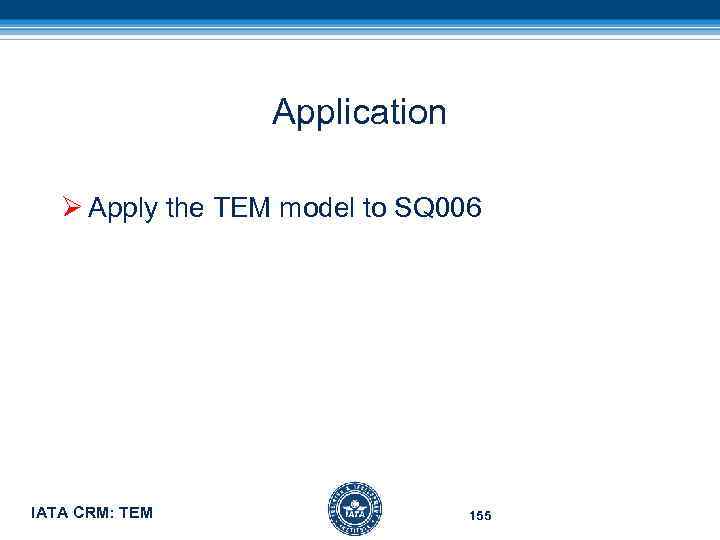 Application Ø Apply the TEM model to SQ 006 IATA CRM: TEM 155
Application Ø Apply the TEM model to SQ 006 IATA CRM: TEM 155
 Application Ø Apply the TEM model to SQ 006 IATA CRM: TEM 156
Application Ø Apply the TEM model to SQ 006 IATA CRM: TEM 156
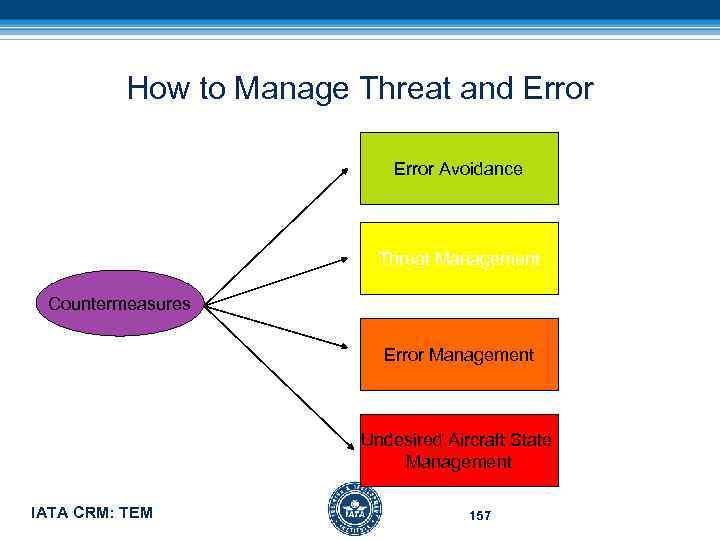 How to Manage Threat and Error Avoidance Threat Management Countermeasures Error Management Undesired Aircraft State Management IATA CRM: TEM 157
How to Manage Threat and Error Avoidance Threat Management Countermeasures Error Management Undesired Aircraft State Management IATA CRM: TEM 157
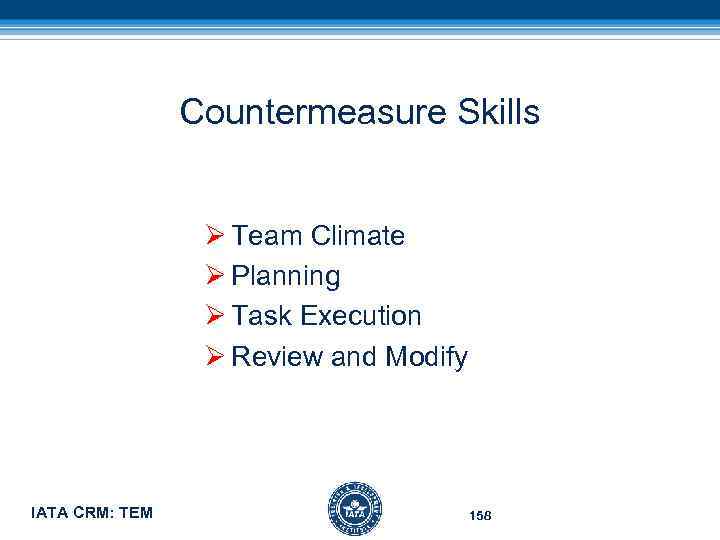 Countermeasure Skills Ø Team Climate Ø Planning Ø Task Execution Ø Review and Modify IATA CRM: TEM 158
Countermeasure Skills Ø Team Climate Ø Planning Ø Task Execution Ø Review and Modify IATA CRM: TEM 158
 How do we apply these skills?
How do we apply these skills?
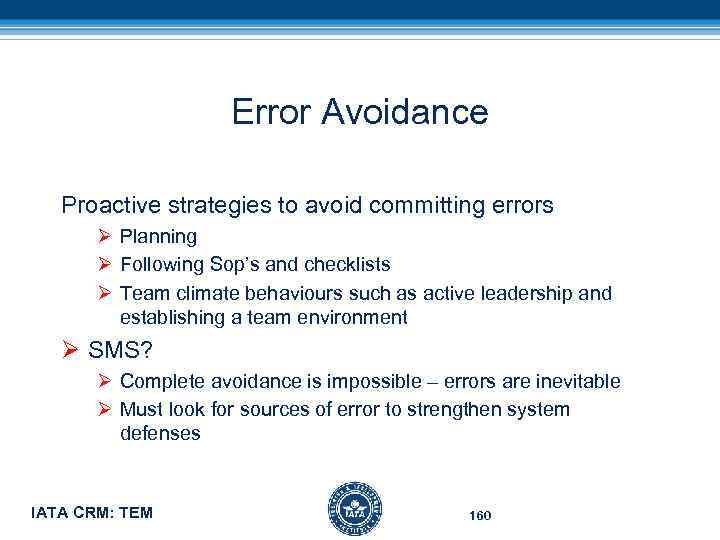 Error Avoidance Proactive strategies to avoid committing errors Ø Planning Ø Following Sop’s and checklists Ø Team climate behaviours such as active leadership and establishing a team environment Ø SMS? Ø Complete avoidance is impossible – errors are inevitable Ø Must look for sources of error to strengthen system defenses IATA CRM: TEM 160
Error Avoidance Proactive strategies to avoid committing errors Ø Planning Ø Following Sop’s and checklists Ø Team climate behaviours such as active leadership and establishing a team environment Ø SMS? Ø Complete avoidance is impossible – errors are inevitable Ø Must look for sources of error to strengthen system defenses IATA CRM: TEM 160
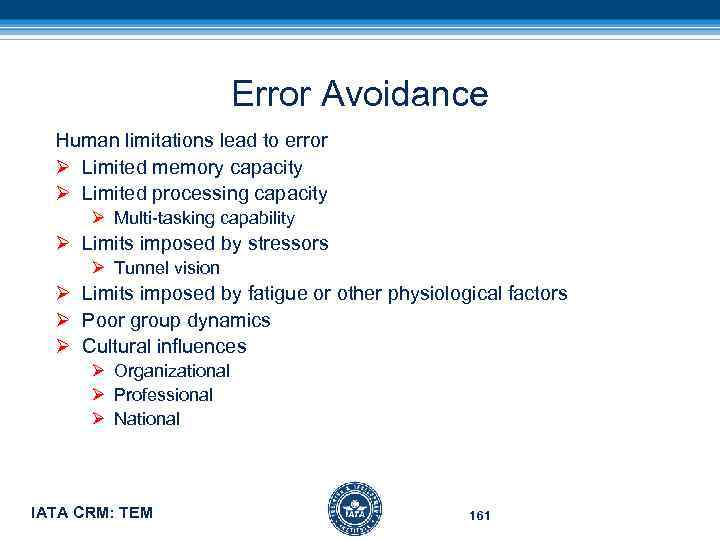 Error Avoidance Human limitations lead to error Ø Limited memory capacity Ø Limited processing capacity Ø Multi-tasking capability Ø Limits imposed by stressors Ø Tunnel vision Ø Limits imposed by fatigue or other physiological factors Ø Poor group dynamics Ø Cultural influences Ø Organizational Ø Professional Ø National IATA CRM: TEM 161
Error Avoidance Human limitations lead to error Ø Limited memory capacity Ø Limited processing capacity Ø Multi-tasking capability Ø Limits imposed by stressors Ø Tunnel vision Ø Limits imposed by fatigue or other physiological factors Ø Poor group dynamics Ø Cultural influences Ø Organizational Ø Professional Ø National IATA CRM: TEM 161
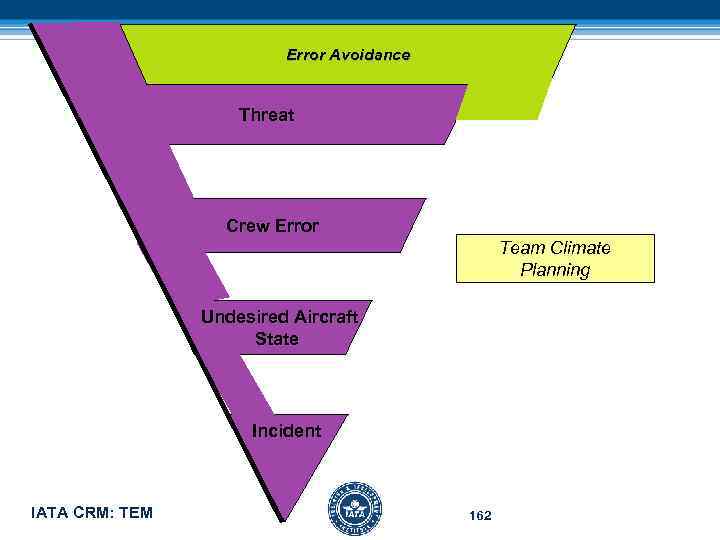 Error Avoidance Threat Crew Error Team Climate Planning Undesired Aircraft State Incident IATA CRM: TEM 162
Error Avoidance Threat Crew Error Team Climate Planning Undesired Aircraft State Incident IATA CRM: TEM 162
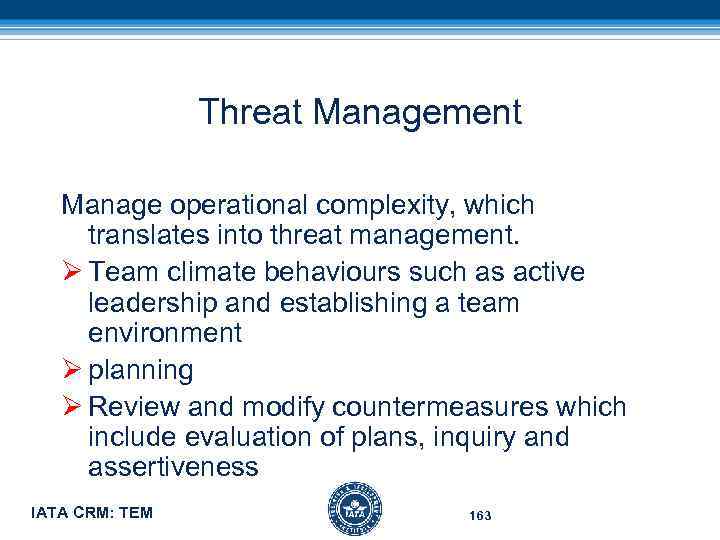 Threat Management Manage operational complexity, which translates into threat management. Ø Team climate behaviours such as active leadership and establishing a team environment Ø planning Ø Review and modify countermeasures which include evaluation of plans, inquiry and assertiveness IATA CRM: TEM 163
Threat Management Manage operational complexity, which translates into threat management. Ø Team climate behaviours such as active leadership and establishing a team environment Ø planning Ø Review and modify countermeasures which include evaluation of plans, inquiry and assertiveness IATA CRM: TEM 163
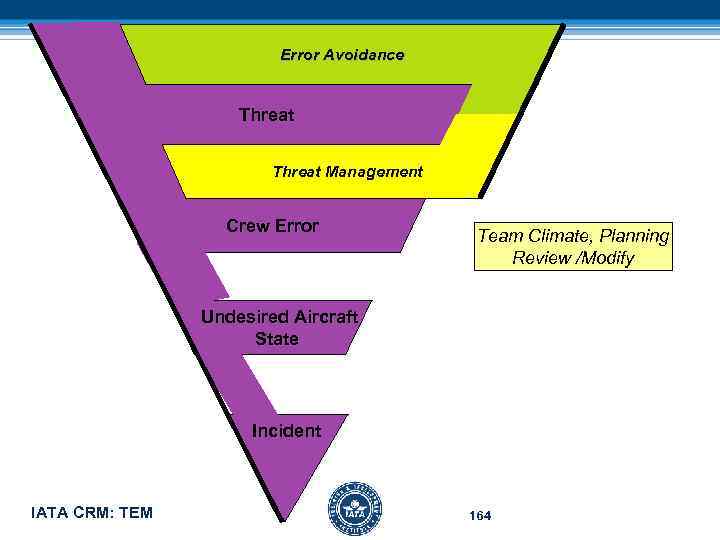 Error Avoidance Threat Management Crew Error Team Climate, Planning Review /Modify Undesired Aircraft State Incident IATA CRM: TEM 164
Error Avoidance Threat Management Crew Error Team Climate, Planning Review /Modify Undesired Aircraft State Incident IATA CRM: TEM 164
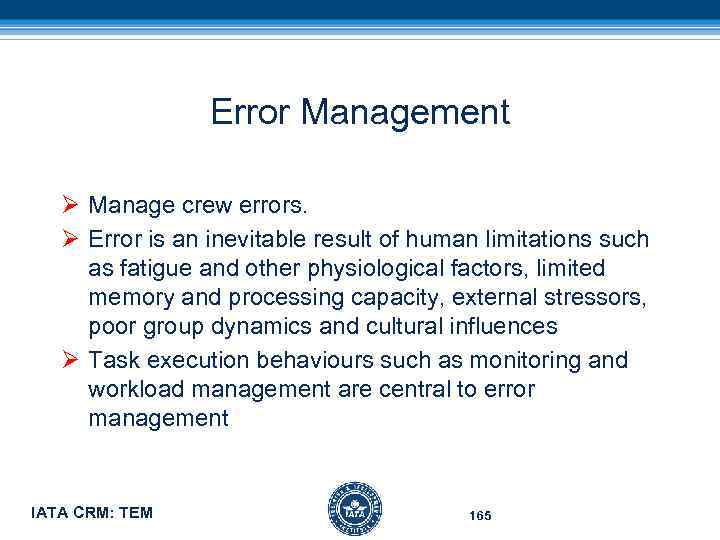 Error Management Ø Manage crew errors. Ø Error is an inevitable result of human limitations such as fatigue and other physiological factors, limited memory and processing capacity, external stressors, poor group dynamics and cultural influences Ø Task execution behaviours such as monitoring and workload management are central to error management IATA CRM: TEM 165
Error Management Ø Manage crew errors. Ø Error is an inevitable result of human limitations such as fatigue and other physiological factors, limited memory and processing capacity, external stressors, poor group dynamics and cultural influences Ø Task execution behaviours such as monitoring and workload management are central to error management IATA CRM: TEM 165
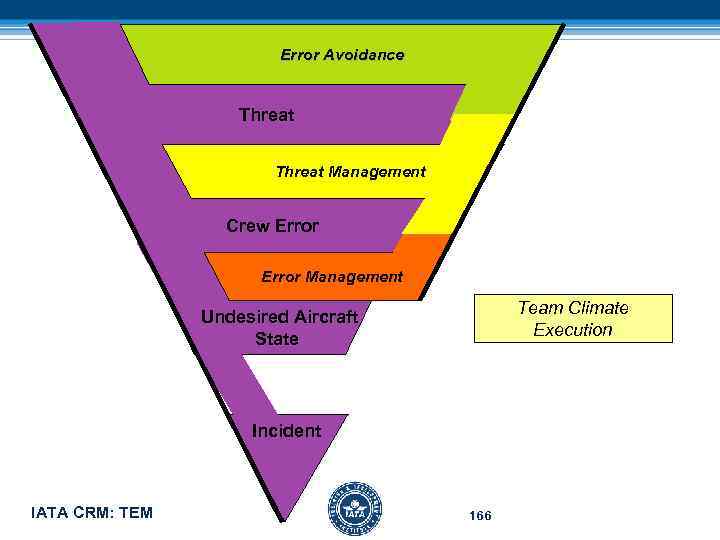 Error Avoidance Threat Management Crew Error Management Team Climate Execution Undesired Aircraft State Incident IATA CRM: TEM 166
Error Avoidance Threat Management Crew Error Management Team Climate Execution Undesired Aircraft State Incident IATA CRM: TEM 166
 Undesired Aircraft State Management Ø Manage aircraft deviations, wrong configurations, speed etc. Ø Review and modify countermeasures which include evaluation of plans, inquiry and assertiveness IATA CRM: TEM 167
Undesired Aircraft State Management Ø Manage aircraft deviations, wrong configurations, speed etc. Ø Review and modify countermeasures which include evaluation of plans, inquiry and assertiveness IATA CRM: TEM 167
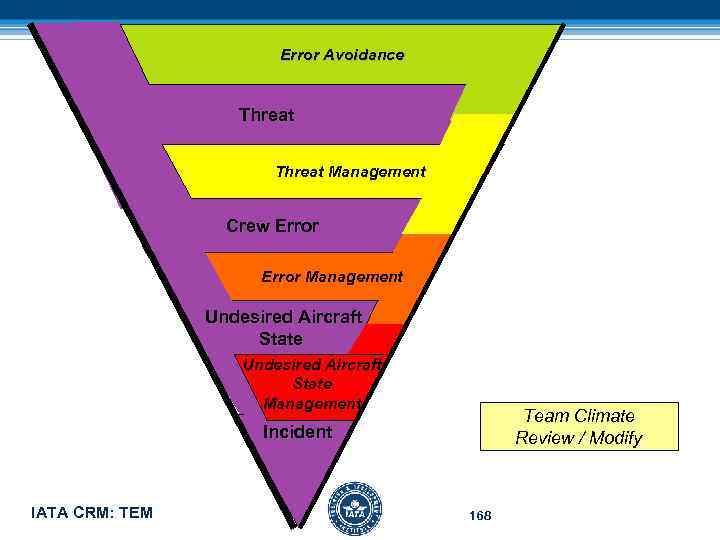 Error Avoidance Threat Management Crew Error Management Undesired Aircraft State Management Team Climate Review / Modify Incident IATA CRM: TEM 168
Error Avoidance Threat Management Crew Error Management Undesired Aircraft State Management Team Climate Review / Modify Incident IATA CRM: TEM 168
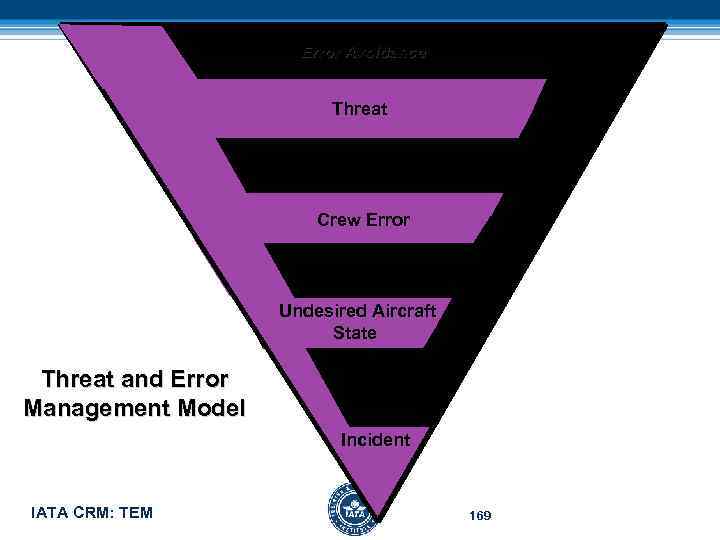 Error Avoidance Threat Management Crew Error Management Undesired Aircraft State Threat and Error Management Model Undesired Aircraft State Management Incident IATA CRM: TEM 169
Error Avoidance Threat Management Crew Error Management Undesired Aircraft State Threat and Error Management Model Undesired Aircraft State Management Incident IATA CRM: TEM 169
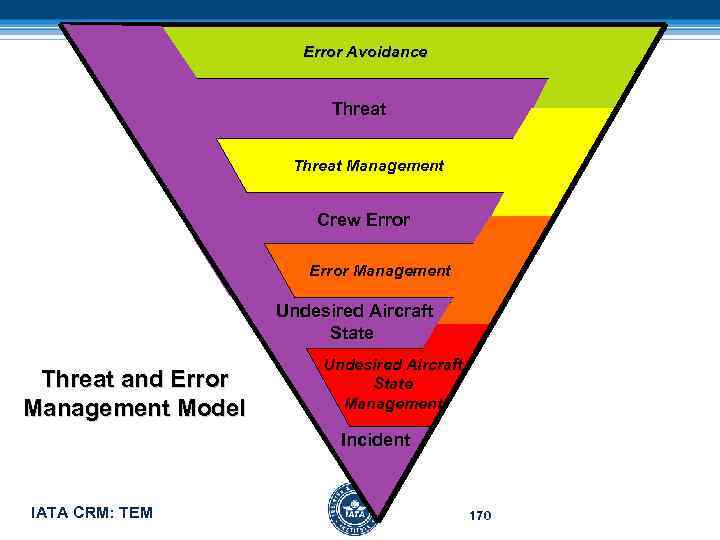 Error Avoidance Threat Management Crew Error Management Undesired Aircraft State Threat and Error Management Model Undesired Aircraft State Management Incident IATA CRM: TEM 170
Error Avoidance Threat Management Crew Error Management Undesired Aircraft State Threat and Error Management Model Undesired Aircraft State Management Incident IATA CRM: TEM 170
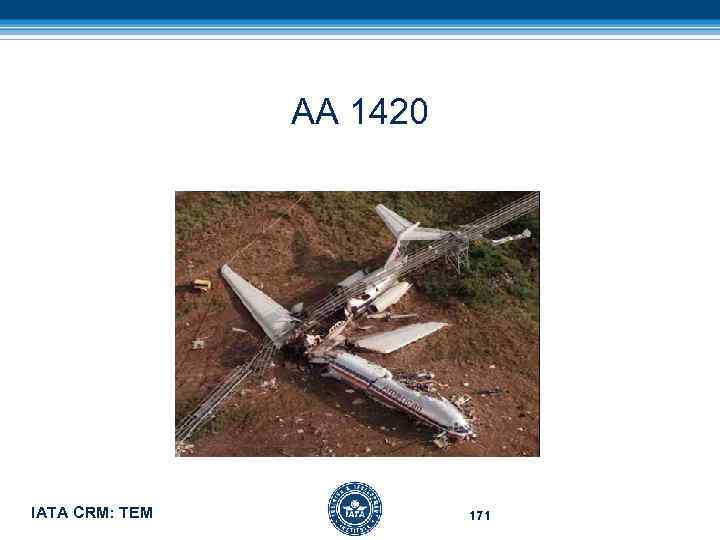 AA 1420 IATA CRM: TEM 171
AA 1420 IATA CRM: TEM 171
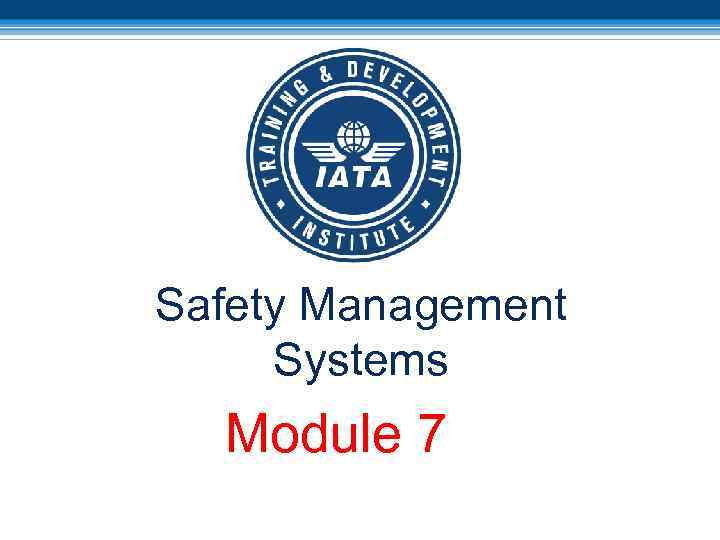 Safety Management Systems Module 7
Safety Management Systems Module 7
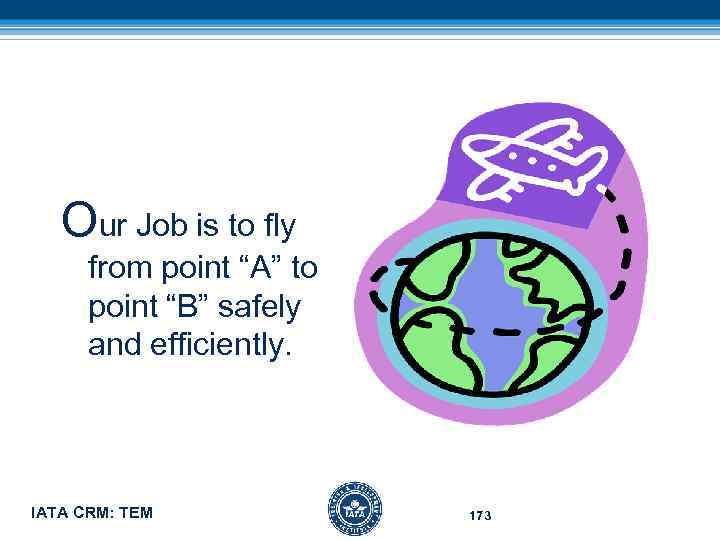 Our Job is to fly from point “A” to point “B” safely and efficiently. IATA CRM: TEM 173
Our Job is to fly from point “A” to point “B” safely and efficiently. IATA CRM: TEM 173
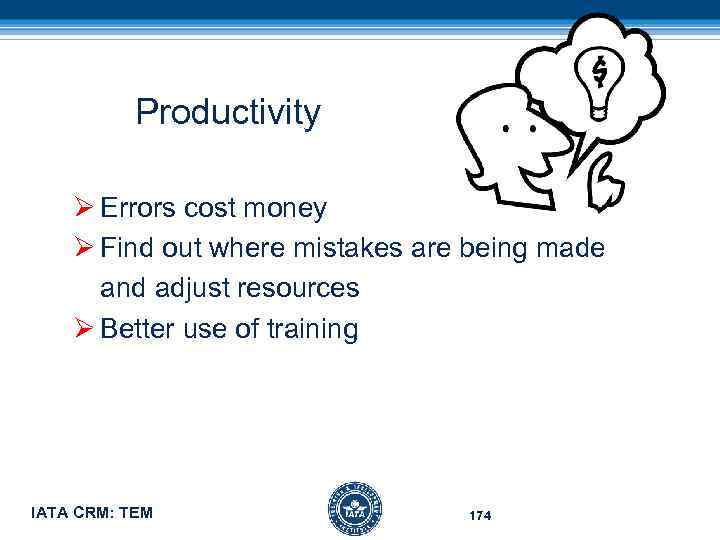 Productivity Ø Errors cost money Ø Find out where mistakes are being made and adjust resources Ø Better use of training IATA CRM: TEM 174
Productivity Ø Errors cost money Ø Find out where mistakes are being made and adjust resources Ø Better use of training IATA CRM: TEM 174
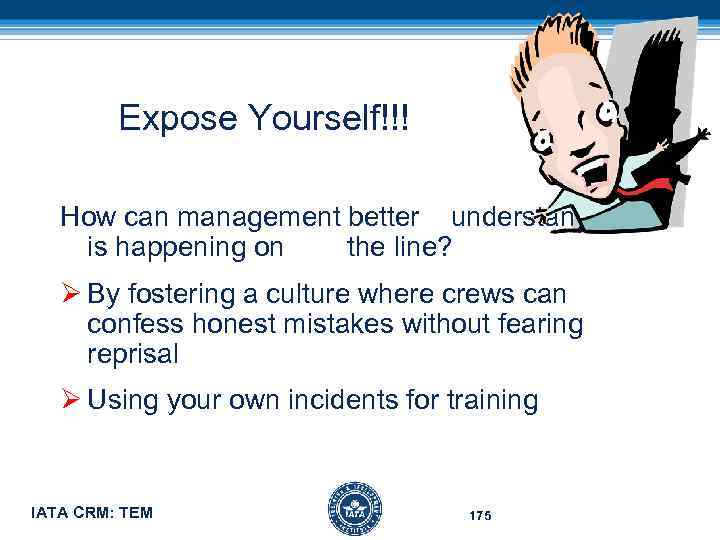 Expose Yourself!!! How can management better understand what is happening on the line? Ø By fostering a culture where crews can confess honest mistakes without fearing reprisal Ø Using your own incidents for training IATA CRM: TEM 175
Expose Yourself!!! How can management better understand what is happening on the line? Ø By fostering a culture where crews can confess honest mistakes without fearing reprisal Ø Using your own incidents for training IATA CRM: TEM 175
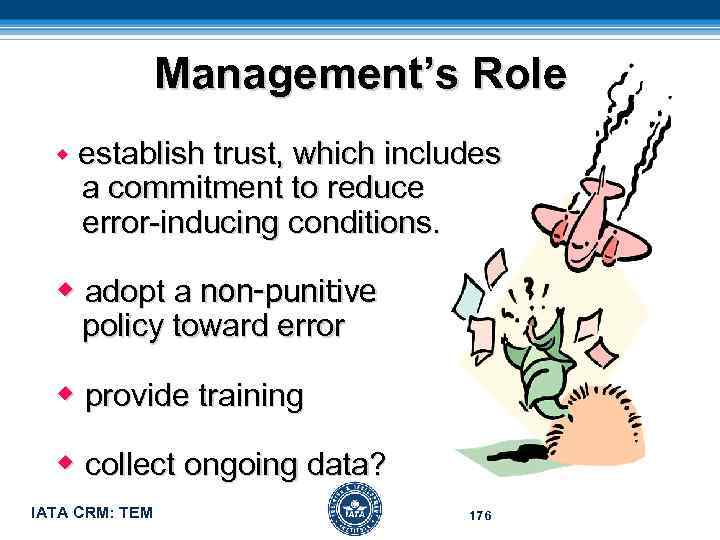 Management’s Role w establish trust, which includes a commitment to reduce error-inducing conditions. w adopt a non-punitive policy toward error w provide training w collect ongoing data? IATA CRM: TEM 176
Management’s Role w establish trust, which includes a commitment to reduce error-inducing conditions. w adopt a non-punitive policy toward error w provide training w collect ongoing data? IATA CRM: TEM 176
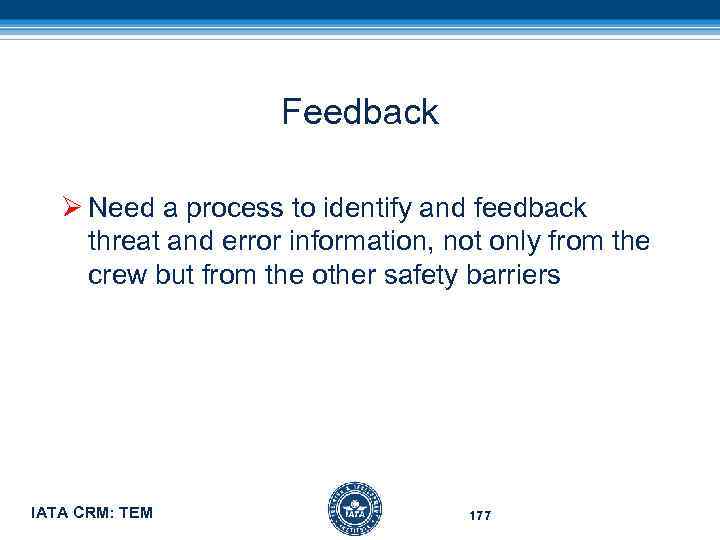 Feedback Ø Need a process to identify and feedback threat and error information, not only from the crew but from the other safety barriers IATA CRM: TEM 177
Feedback Ø Need a process to identify and feedback threat and error information, not only from the crew but from the other safety barriers IATA CRM: TEM 177
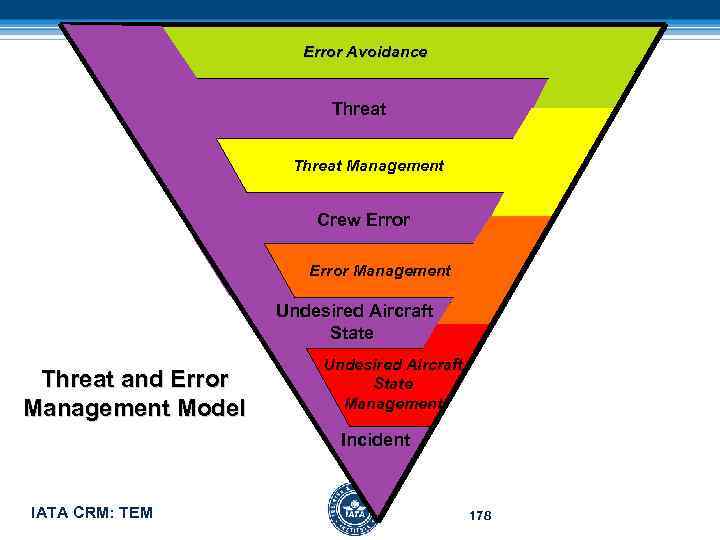 Error Avoidance Threat Management Crew Error Management Undesired Aircraft State Threat and Error Management Model Undesired Aircraft State Management Incident IATA CRM: TEM 178
Error Avoidance Threat Management Crew Error Management Undesired Aircraft State Threat and Error Management Model Undesired Aircraft State Management Incident IATA CRM: TEM 178
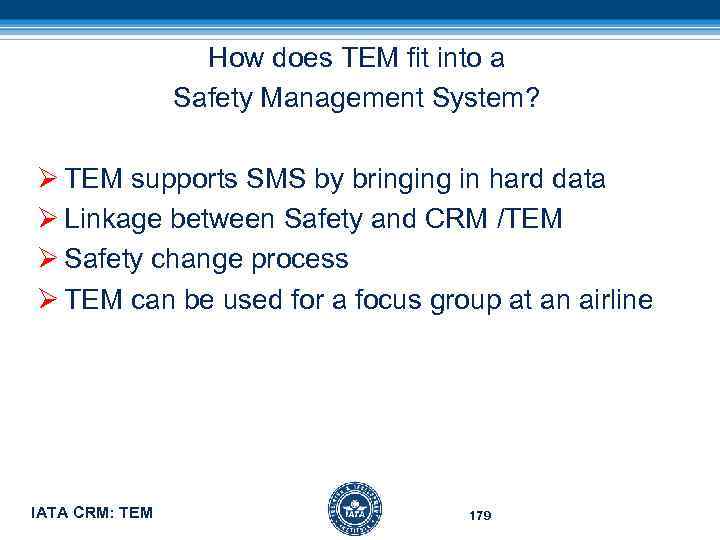 How does TEM fit into a Safety Management System? Ø TEM supports SMS by bringing in hard data Ø Linkage between Safety and CRM /TEM Ø Safety change process Ø TEM can be used for a focus group at an airline IATA CRM: TEM 179
How does TEM fit into a Safety Management System? Ø TEM supports SMS by bringing in hard data Ø Linkage between Safety and CRM /TEM Ø Safety change process Ø TEM can be used for a focus group at an airline IATA CRM: TEM 179
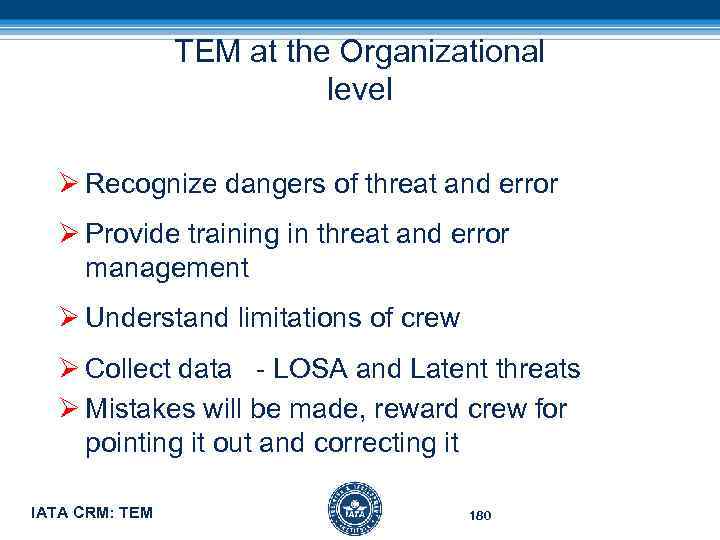 TEM at the Organizational level Ø Recognize dangers of threat and error Ø Provide training in threat and error management Ø Understand limitations of crew Ø Collect data - LOSA and Latent threats Ø Mistakes will be made, reward crew for pointing it out and correcting it IATA CRM: TEM 180
TEM at the Organizational level Ø Recognize dangers of threat and error Ø Provide training in threat and error management Ø Understand limitations of crew Ø Collect data - LOSA and Latent threats Ø Mistakes will be made, reward crew for pointing it out and correcting it IATA CRM: TEM 180
 Data Collection Company, industry and regulating authorities get information of the “real” problems that line pilots face Cannot prevent the creation of latent threats but make their adverse consequence visible to those who manage and operate the system IATA CRM: TEM 181
Data Collection Company, industry and regulating authorities get information of the “real” problems that line pilots face Cannot prevent the creation of latent threats but make their adverse consequence visible to those who manage and operate the system IATA CRM: TEM 181
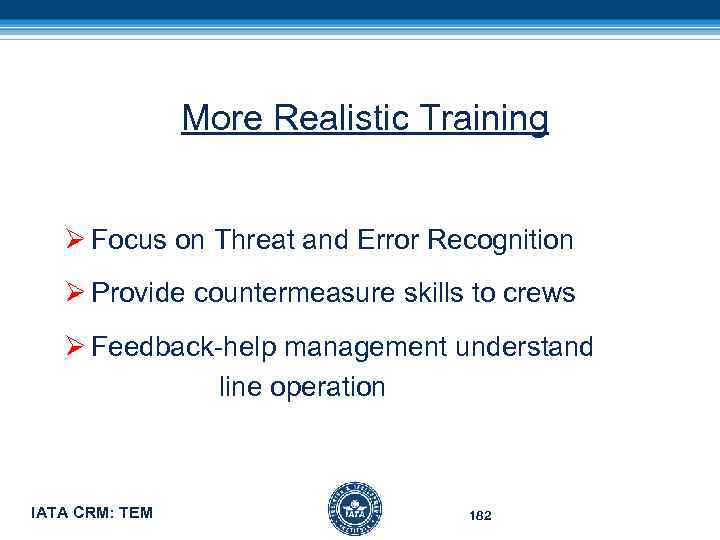 More Realistic Training Ø Focus on Threat and Error Recognition Ø Provide countermeasure skills to crews Ø Feedback-help management understand line operation IATA CRM: TEM 182
More Realistic Training Ø Focus on Threat and Error Recognition Ø Provide countermeasure skills to crews Ø Feedback-help management understand line operation IATA CRM: TEM 182
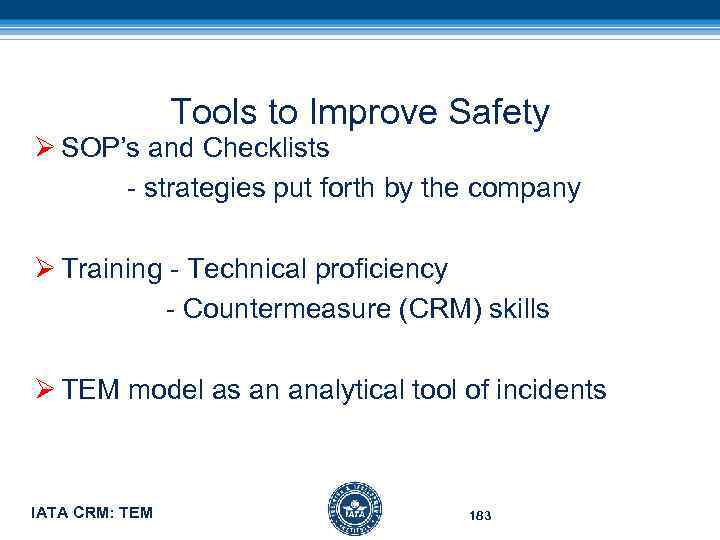 Tools to Improve Safety Ø SOP’s and Checklists - strategies put forth by the company Ø Training - Technical proficiency - Countermeasure (CRM) skills Ø TEM model as an analytical tool of incidents IATA CRM: TEM 183
Tools to Improve Safety Ø SOP’s and Checklists - strategies put forth by the company Ø Training - Technical proficiency - Countermeasure (CRM) skills Ø TEM model as an analytical tool of incidents IATA CRM: TEM 183
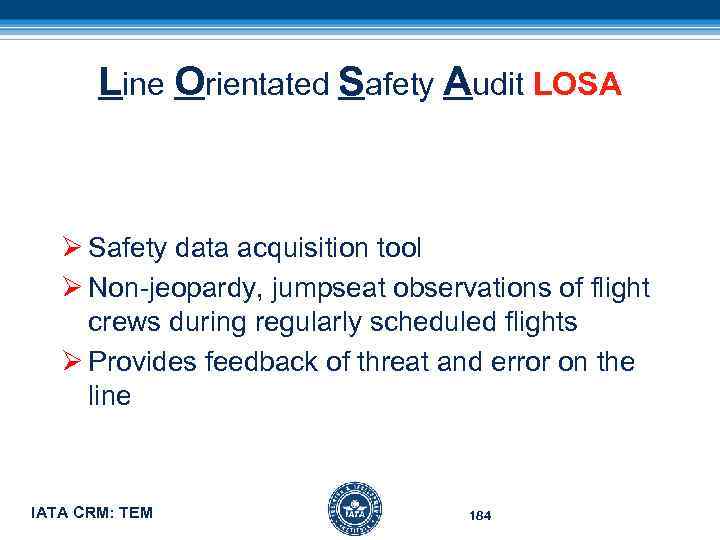 Line Orientated Safety Audit LOSA Ø Safety data acquisition tool Ø Non-jeopardy, jumpseat observations of flight crews during regularly scheduled flights Ø Provides feedback of threat and error on the line IATA CRM: TEM 184
Line Orientated Safety Audit LOSA Ø Safety data acquisition tool Ø Non-jeopardy, jumpseat observations of flight crews during regularly scheduled flights Ø Provides feedback of threat and error on the line IATA CRM: TEM 184


